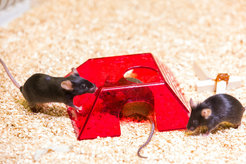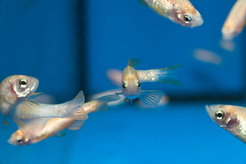Basic research without animal testing?
Taking responsibility for the opportunities and limitations of alternative methods
To the point:
- Alternative methods do not always work: Cell cultures and biochips are not yet capable of replicating complex biological processes in humans, which is why animal experiments remain necessary in some areas of basic research.
- The Max Planck Society's 4R principle: Researchers at the Max Planck Society act in line with the extended 4R principle (reduction, refinement, replacement, responsibility), which ensures that animal experiments are ethically sound and critically questions their necessity.
- Basic research remains dependent on experiments on model organisms: Model organisms such as mice and zebrafish play an important role, especially in neuroscience and behavioral research, as they are genetically and physiologically similar to humans.
Animal testing is an emotional issue, and many people find it difficult to understand why it is necessary. In fact, computer-assisted models or cell-based cultures can already be used in basic research in certain cases. Some questions, such as the role of sleep in memory formation, are even being investigated directly in humans.
However, methods involving humans, computers, or cell laboratories are not always applicable, which is why animals are also used in special cases. Experiments on vertebrates such as mice or zebrafish must be justified and ethically acceptable. Their justification in basic research is therefore always a matter of weighing up the actual beneficial effects of using laboratory animals.
Research according to the 4R principle

In scientific practice, the answer to the question of whether animal experiments should be conducted at all is a process clearly defined by law and subject to very high ethical standards. Scientists are guided by the so-called 3R principle: animal experiments should always be reduced (reduction), improved (refinement) and, whenever possible, replaced (replacement). At the Max Planck Institutes, this principle is supplemented by a further “R”: responsibility – the personal responsibility of every scientist to always critically question the use of animals, to justify it ethically, and to always take personal responsibility for it.
“At the Max Planck Institutes, we are committed to improving the social life of animals, further developing tools to determine their ability to feel, their consciousness and intelligence, and actively engaging in public discussion on the topic of animal ethics,” explains PD Dr. Thomas Ott, who is responsible for neuroscientific models, animal research, and biosafety at the Max Planck Institute for Biological Cybernetics. “However, the consistent implementation of these principles in all areas of animal research is ultimately the prerequisite for animal experiments to be approved by the competent authorities,” explains the biologist.
There is more mice in us than we think
If we want to get to the bottom of the causes of neural diversity and find treatments for diseases such as Alzheimer's or Parkinson's, we need to study the electrophysical and biochemical processes of the brain and the central nervous system. These processes are fundamentally the same in humans and animals.

Photograph: Jörg Abendroth
Mice in particular are frequently used in animal experiments because their genes can be specifically modified or switched off – ideal for researching the genetic basis of diseases. Their close genetic relationship to humans (up to 95 percent similarity) makes them particularly valuable for neuromedical research, for example in Alzheimer's disease. Transgenic mice enable more precise experiments and have contributed significantly to advances in the treatment of diseases.
"The genetic makeup of a mouse differs only slightly from ours. This makes it possible to investigate genetic causes of biochemical imbalances by selectively switching off genetic information in mice. This enables us to draw conclusions about humans,“ Thomas Ott continues. ”All of today's achievements in medicine are ultimately based on findings from basic research. If we know why, when, and where certain disease-causing or inherited disorders occur in the brain, it is also possible to develop targeted treatments for them."
Big picture for a tiny fish
Zebrafish are now used as model organisms in many areas of biological research. Nobel Prize winner Christiane Nüsslein-Volhard worked with them at the Max Planck Campus in Tübingen in the 1990s to uncover the links between genetically inherited color patterns in fish and their attractiveness during mating.

At the Max Planck Institute for Biological Cybernetics, they literally swim in front of the lens of a light microscope developed in-house, which uses intelligent software to track the behavior of the larvae and observe them in various situations. In the early stages of their development, zebrafish larvae still have a transparent skull, so that fluorescent light can be used to map processing in the brain in real time. The visual data is then analyzed using computer-assisted methods.
For these experiments, the tiny zebrafish can do whatever they want. “For behavioral research like this, it is particularly important that the animals feel comfortable and that their perception corresponds to that of a normal living environment. Any deviation due to negative influencing factors would distort the behavioral data collected or make it unusable,” says Ott.
The zebrafish are housed in small aquariums where the swarms live together in small numbers. “If there were too many fish in one of our aquariums, social stress would quickly arise. Rivalry would also be likely.
Opportunities and limitations of alternative methods
Organ-on-a-chip technology is considered a promising alternative to animal testing. It involves growing organ-like structures, known as organoids, from stem cells. Although they lack blood vessels and connective tissue, they exhibit the typical characteristics of real organs. Three-dimensional cell and tissue models are created on a plastic chip as replicas of real tissue structures.

Membranes and tiny channels ensure oxygen exchange and the transport of nutrients. Several different organoids can also be connected to each other to replicate the interaction of organs outside the body in an artificial circuit.
"Biochips are already delivering promising results in drug development, for example by testing the effect of an active ingredient directly on organoids. This shows whether a substance affects the cell tissue – however, it cannot be ruled out that substances that are unremarkable in the model may still cause damage in the human organism," argues Ott.
Biochips are also reaching their limits in other areas: only a few organ models can be combined so far, and certain cell types do not grow in culture. This means that complex processes such as emotions, the cardiovascular system, or hormonal interactions cannot yet be reproduced.
“Nevertheless, intensive research is being conducted worldwide to further develop biochips. However, there are currently clear limits to what can be transferred from the biochip model to humans and other living beings. Behavioral studies are also not possible.”
According to Ott, it is therefore important to remain transparent and honest when communicating alternative methods so as not to raising false hopes. It is simply not yet possible to completely dispense with animal testing in basic research. Even for the verification of research results from organ-on-a-chip models, animal testing is still necessary.



